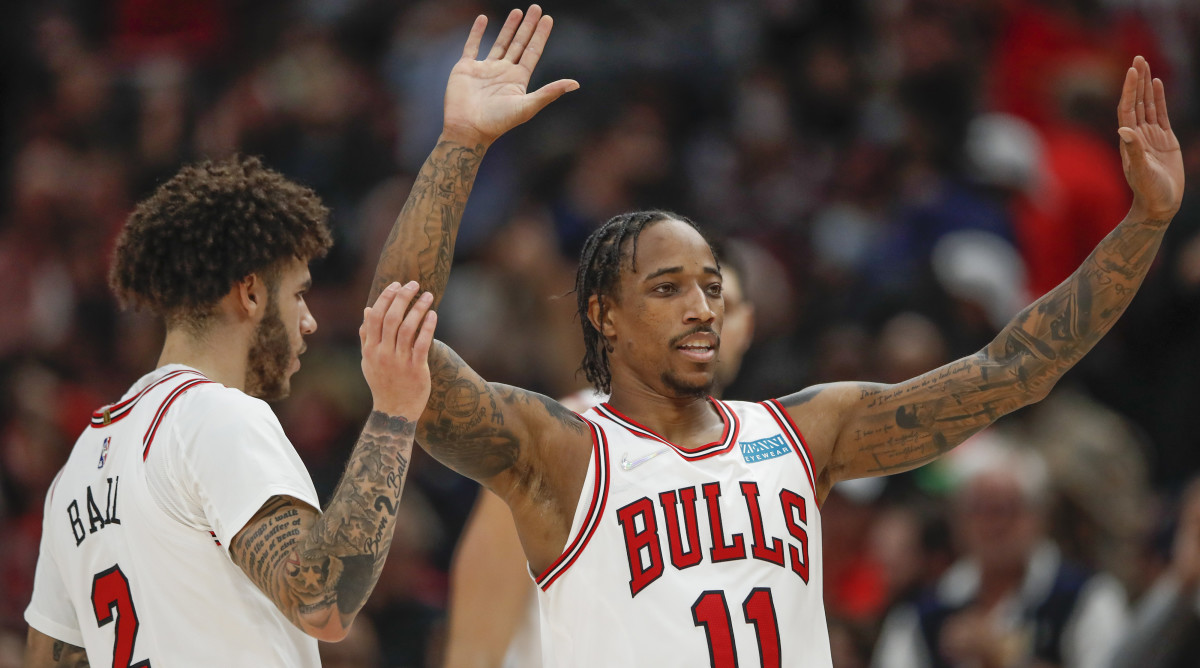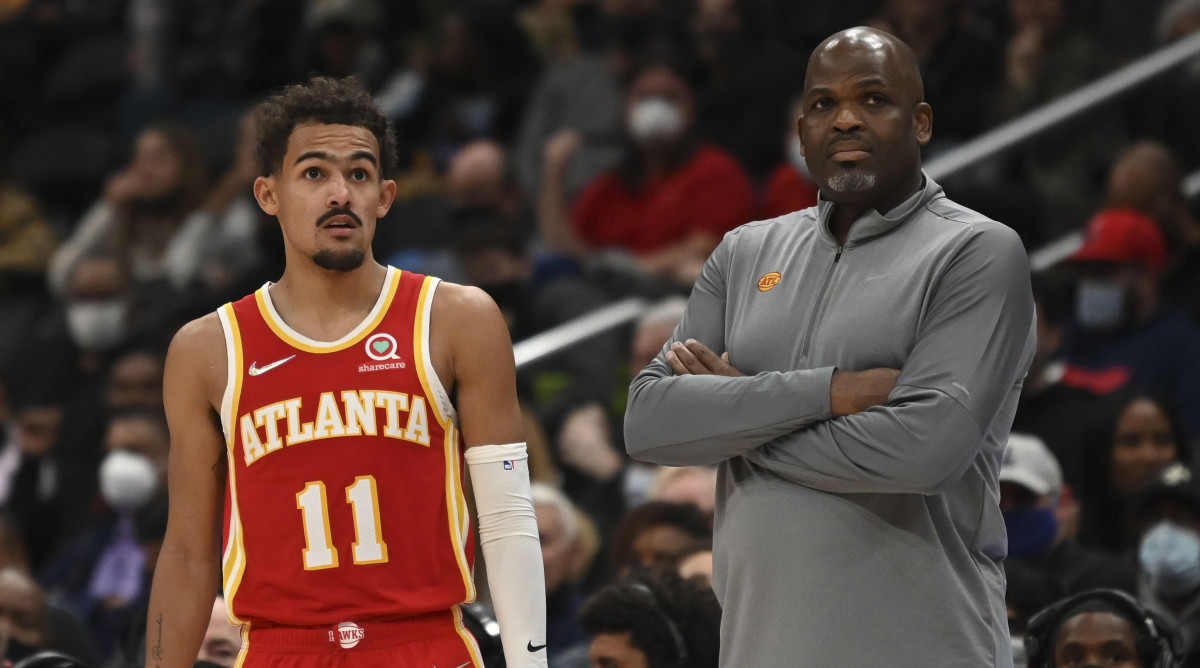Three Strange Developments in the Eastern Conference

By almost any measure, this has been a strange NBA season.
Aside from the fact that Harrison Barnes was looking like more of an early MVP candidate than Damian Lillard, there’s also the fact that Cleveland—Cleveland!—is 7–5 through 12 games. You have to go back 21 years to find the last time the Cavaliers were this far above .500 this late in a campaign without a man named LeBron on their roster.
It requires going back much further than that, to 1975, to find the last time Washington finished with the most wins in the Eastern Conference. Yet the new-look Wizards are currently tied for the best record in the East, even though franchise player Bradley Beal hasn’t played anywhere near his best to this point.
With all that in mind, we broke down three of the more odd aspects of the young season thus far.

The Bulls are winning … with defense?
While Chicago undoubtedly stood as one of the league’s most intriguing teams heading into this season, most of that intrigue—if not all of it—stemmed from the club’s offensive capabilities.
Seeing the Bulls through that prism made sense. After all, they already had Zach LaVine, quietly one of the NBA’s best scorers. They’d finally get to see him in extended action with center Nikola Vucevic, the pick-and-pop beast the organization dealt for at the 2021 trade deadline. Beyond that, adding DeMar DeRozan, a free-throw-line inhabitant who’s always had to carry more than his share of scoring responsibilities, would relieve some of the pressure LaVine felt to create from the wing and vice versa.
So it’s not necessarily surprising that their offense ranks sixth best in basketball, especially as free-agent pickup Lonzo Ball drills his almost seven three-point attempts per game at a 44.7% clip.
But in one of the more interesting and perhaps consequential developments of the season so far, the Bulls—tied with the Wizards for the East’s best mark—are showing lockdown tendencies on defense.
Most Chicago fans would have gladly taken “not bad” on defense, given the team’s perceived deficiencies on that side of the ball. DeRozan gets lost on the perimeter like a tourist who doesn’t speak the language, and stretch bigs figured to pose a problem for Vucevic. But not only is Chicago not bad there, it's actually excelling just as much on that end of the floor—ranked sixth—as it is on offense.
Taking things one step further: The club has been the stingiest defense in the NBA in fourth quarters—more than the Clippers, Warriors, or Jazz—when getting stops take on added importance.
While many weren’t believers in the Bulls’ ability to get stops, the team appears to have struck gold with its closing lineup of Ball, LaVine, DeRozan, Vucevic and free-agent signee Alex Caruso. (We’ll take credit for having had faith in this lineup’s defensive chops—even as far back as the summer.) Caruso has been a high-value hound, not only leading the league in steals while coming off the bench, but also logging more deflections per minute than any other player in the NBA.
CARUSO STEAL.
— NBA (@NBA) November 11, 2021
LONZO FULL-COURT LASER.
LAVINE 360.
SHOWTIME IN CHICAGO 🤯🤯🤯 pic.twitter.com/C8ViDSoMXG
In just the first three and a half weeks of play alone, the Bulls have held the following teams scoreless for lengthy fourth-quarter stretches:
- Brooklyn for 3:56
- Philadelphia for 4:05
- Boston for 4:13
- New York for the final 2:59; a span in which the Bulls trimmed a 13-point deficit to one before losing on the final play of the game.
If the Bulls are back, offense will be part of it. But more and more, it’s looking like defense will be, too.
The Magic are rebuilding … but have arguably the best-performing starting five so far
Outside of perhaps the Thunder, there might not have been a team with lower expectations than Orlando. The Magic play for a first-time head coach in Jamahl Mosley and have one of the youngest starting fives in NBA history: Cole Anthony is 21, Jalen Suggs 20, Mo Wagner 20, Wendell Carter 22, and Mo Bamba is 23.
Watch the young club often enough, though, and a clear pattern emerges. For all of its youth, the starting unit routinely establishes breathing room for its backups. That group, which had the league’s best net rating among starting fives until Wednesday, is beating opponents by 15 points per 100 possessions.
But those leads vanish like Mickey Mouse funnel cakes at a Disney park: there one minute, then literally gone the next.
Take a look at this chart, separating the starting five’s game-by-game performance as a group versus every other grouping the Magic use over the course of a contest. Of the 12 games Orlando has logged to this point, the starters have come out ahead—meaning they had a positive on the plus/minus side—nine separate times this season. By contrast, the other rotations have finished as a net negative in 11 of those 12 matchups, often by a massive margin.
Game Number | Opponent | Starting Five Plus-Minus | Other Lineup Plus-Minus |
|---|---|---|---|
Game 1 | Spurs | 7 | -33 |
Game 2 | Knicks | 4 | -29 |
Game 3 | Knicks | 7 | -1 |
Game 4 | Heat | 3 | -20 |
Game 5 | Hornets | 9 | -18 |
Game 6 | Raptors | 13 | -14 |
Game 7 | Pistons | -6 | -1 |
Game 8 | Timberwolves | 6 | 12 |
Game 9 | Celtics | -10 | -3 |
Game 10 | Spurs | 6 | -19 |
Game 11 | Jazz | 9 | -2 |
Game 12 | Nets | -5 | -28 |
There was the season opener against the Spurs, for instance: a game when the starters collectively beat San Antonio by seven points, but the other alignments got waxed by 33. (The same thing happened when the clubs faced off a second time last week: The starting five was a plus-6, while the other lineups finished a minus-19.) Or the Magic’s second game of the year, when the starters were a plus-four, but the lineups that came after notched a minus-29. Or the one-point loss to the Raptors, where the starters finished a plus-13, but the other rotations logged a minus-14.
The pattern sums things up pretty clearly. Between Anthony, Carter and Bamba all having fantastic, bounceback seasons, and Franz Wagner looking better than literally anyone projected this soon, the Magic got game. There’s just not much waiting in reserve, save for R.J. Hampton and an always-willing shooter in Terrence Ross, once those first five need a breather. With limited depth—Jonathan Isaac, Markelle Fultz, Michael Carter-Williams and E’Twaun Moore are out with injuries—Orlando is a league-worst minus-23.8 per 100 possessions with two or fewer starters on the court this season, according to data provided by Stats Perform. (Interestingly, the story is much the same with the Pelicans, who, at 1–11, regularly build leads, only to see the bench squander them. The Pels’ bench has gotten blasted by minus-23.5 per 100 possessions this season.)
It might suggest that the Magic have the makings of something good once they’re closer to whole. But until then, don’t expect too many Disney-style endings in Orlando games with the starters having to compensate that much for a bench full of holes.

The Hawks were supposed to take over the East. So why do they look so lost?
If there was a sexy pick this season in the Eastern Conference this season, the Hawks were it.
They were coming off a campaign in which they fell just two games shy of reaching the NBA Finals. They’re young, with a young star, and a relatively new coach who got the most out of them with a massive, late-season turnaround after being put in place. There was seemingly no massive reasons to expect that they’d struggle. (Although, again: Some of us warned before the campaign that maybe analysts were a little too jazzed about the way they finished last season coming into this one.)
So now, with Atlanta just 4–8, what are we supposed to think? What’s happened to the Hawks?
We can start with the most obvious assessment: Yes, Atlanta has played a brutal schedule to begin the year; the third-toughest in the NBA to this point. (Although you’ll notice that the team with the hardest slate, Memphis, has a winning record behind the brilliant play of its young point guard.) The Hawks’ last five games alone—at Utah, at Golden State, at Phoenix, at home against Utah and at Brooklyn—were a murderer’s row. And Atlanta, on a five-game skid, dropped each of those games.
But there’s far more to choose from. If you, for instance, were drawn to the Hawks’ depth—particularly with the full-time return of highly talented wings De’Andre Hunter and Cam Reddish—then it was only fair to wonder how their availability would impact the rotation as a whole. Results have been mixed. Kevin Huerter, down eight minutes per game, has been the man to lose the most playing time since last season—a tough reality on a night where he shoots 7-for-9 from the floor, but plays only 23 minutes. (Though coach Nate McMillan has had a bit of quicker hook for Reddish lately when he shoots poorly.)
The potential logjam and how a group of younger players balance that spotlight with the notion of winning—something my colleague Michael Pina touched on in his Hawks season preview—remains worth watching this season. Especially if the confident team struggles to put things together for a while.
Somewhat predictably, Trae Young is getting to the line far less—7.4 free throws per 100 possessions, as opposed to 12.6 last year—now that the rules don’t allow him to initiate unnatural contact with defenders as a way to draw shooting fouls. Perhaps an even bigger factor, as pointed out by ESPN’s Zach Lowe: The Hawks have quietly fallen in love with long midrange jumpers this season, trailing only the Lakers and Bulls in terms of their shot frequency from that spot on the floor, per Cleaning the Glass. That’s a stark contrast from last year, when they ranked 17th in their shots from there. But maybe it’s a shift we should have seen coming. McMillan has long encouraged his teams to take open looks for the sake of tempo, even if those looks are the sort of midrange ones the defense wants you to take.
The defense is an even bigger problem. Atlanta is third worst in points allowed per transition possession, and the club ranks dead last in one-on-one defense, according to Synergy Sports, hemorrhaging 1.08 points per isolation play. Center Clint Capela, who was rehabbing an Achilles injury throughout the offseason, has struggled to make the sort of rim-protecting impact he did last year, when he looked like a worthy Defensive Player of the Year candidate.
With a 52.4% field-goal percentage that marks Capela’s lowest since his rookie season, the big man is finishing less effectively on offense. Yet opposing offenses are having their way with the Hawks, shooting a league-best 70.3% at the rim so far. Much of that stems from Capela not looking himself.
It’s early yet, and the schedule will get easier. But if Atlanta isn’t potentially the dominant team that so many pegged them to be just yet, the Hawks will need to pick things up soon to avoid losing too much ground in a suddenly strong Eastern Conference.
More NBA Coverage:
• NBA Power Rankings: Are the Warriors the Best Team in the NBA?
• Kevin Durant Is Doing It All for the Nets
• Evan Mobley Is Doing Impossible Things for the Cavs
• NBA Draft Notebook: Banchero Strengthens Case for No. 1 Pick
Sports Illustrated may receive compensation for some links to products and services on this website.
